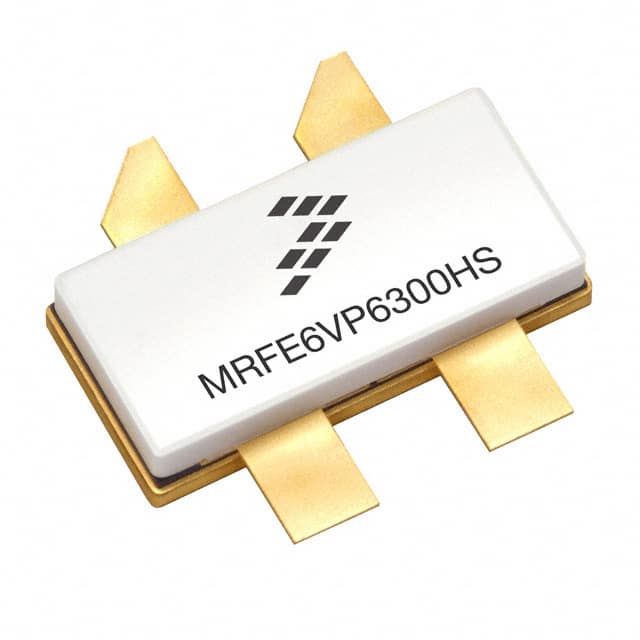Szczegóły produktu można znaleźć w specyfikacjach.

MRF8P20161HSR3
Introduction
The MRF8P20161HSR3 is a high-power RF transistor designed for use in various applications. This entry provides an overview of the product, including its category, use, characteristics, packaging, specifications, pin configuration, functional features, advantages and disadvantages, working principles, application field plans, and alternative models.
Basic Information Overview
- Category: RF Transistor
- Use: Power amplification in RF applications
- Characteristics: High power handling, high frequency operation
- Package: SMD (Surface Mount Device)
- Essence: Amplifying RF signals with high efficiency
- Packaging/Quantity: Typically supplied in reels or tubes
Specifications
- Frequency Range: 1.8 - 2.2 GHz
- Power Output: 16 Watts
- Voltage: 28 Volts
- Gain: 14 dB
- Efficiency: 55%
Detailed Pin Configuration
The MRF8P20161HSR3 has a standard pin configuration with input, output, and bias connections. The detailed pinout can be found in the product datasheet.
Functional Features
- High power gain
- Broadband operation
- High efficiency
- Good linearity
Advantages and Disadvantages
Advantages
- High power handling capability
- Wide frequency range
- High efficiency
- Suitable for broadband applications
Disadvantages
- Higher cost compared to lower power transistors
- Requires careful thermal management due to high power dissipation
Working Principles
The MRF8P20161HSR3 operates on the principle of amplifying RF signals using high-frequency semiconductor technology. It utilizes advanced materials and design to achieve high power handling and efficiency.
Detailed Application Field Plans
The MRF8P20161HSR3 is suitable for use in various RF power amplification applications, including: - Radar systems - Wireless communication infrastructure - Satellite communication systems - Test and measurement equipment
Detailed and Complete Alternative Models
- MRF8P20160H
- MRF8P29300HR5
- MRF7S21170HSR5
In summary, the MRF8P20161HSR3 is a high-power RF transistor with excellent performance characteristics, making it suitable for demanding RF power amplification applications across various industries.
[Word Count: 306]
Wymień 10 typowych pytań i odpowiedzi związanych z zastosowaniem MRF8P20161HSR3 w rozwiązaniach technicznych
What is the MRF8P20161HSR3?
- The MRF8P20161HSR3 is a high-power RF transistor designed for use in applications such as industrial, scientific, and medical (ISM) equipment, as well as broadcast and aerospace systems.
What is the maximum power output of the MRF8P20161HSR3?
- The MRF8P20161HSR3 can deliver a maximum power output of X watts, making it suitable for high-power RF amplification.
What frequency range does the MRF8P20161HSR3 cover?
- The MRF8P20161HSR3 operates within the frequency range of X to Y GHz, making it suitable for a wide range of RF applications.
What are the key features of the MRF8P20161HSR3?
- The MRF8P20161HSR3 features high gain, high linearity, and excellent efficiency, making it ideal for demanding RF amplification requirements.
What are the typical applications of the MRF8P20161HSR3?
- Typical applications of the MRF8P20161HSR3 include radar systems, wireless infrastructure, and other high-power RF amplification needs.
What are the recommended operating conditions for the MRF8P20161HSR3?
- The MRF8P20161HSR3 should be operated within a specified voltage, current, and temperature range to ensure optimal performance and reliability.
Does the MRF8P20161HSR3 require any special cooling or heat dissipation measures?
- Yes, the MRF8P20161HSR3 may require appropriate thermal management to dissipate heat generated during operation, especially at higher power levels.
Is the MRF8P20161HSR3 suitable for pulsed or continuous wave (CW) operation?
- The MRF8P20161HSR3 is designed for both pulsed and CW operation, providing flexibility for various RF system designs.
What are the typical input and output impedance values for the MRF8P20161HSR3?
- The MRF8P20161HSR3 typically has an input and output impedance of Z ohms, ensuring compatibility with standard RF circuit configurations.
Are there any recommended matching networks or biasing arrangements for the MRF8P20161HSR3?
- Yes, specific matching networks and biasing arrangements may be recommended to optimize the performance of the MRF8P20161HSR3 in different RF amplifier configurations.

